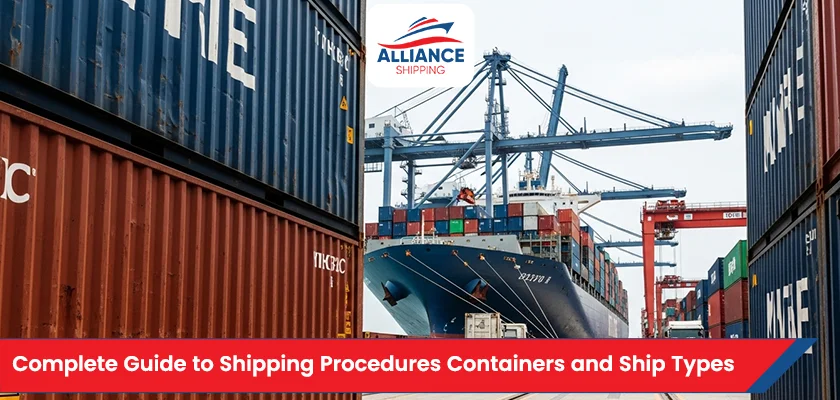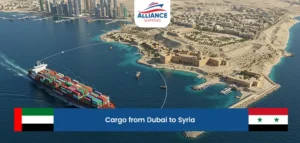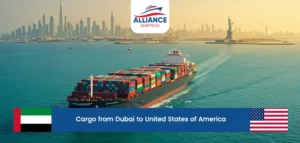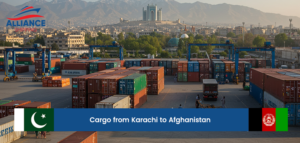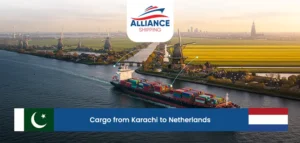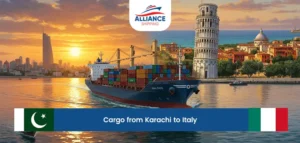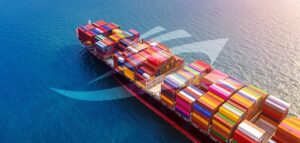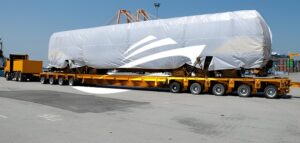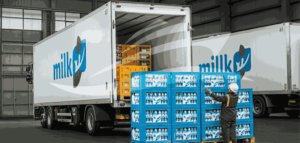The term ‘shipping’ is something we often hear in everyday life, usually in the context of online shopping or having a parcel delivered to our doorstep. However, in the professional world, when we talk about shipping goods, it mostly falls within the B2B domain, i.e., business to business. Across the globe, shops, stores, and supermarkets all rely on importing cargo in order to keep their shelves stocked and their businesses running. The cargo is not limited to electronics, clothing, raw materials, food products, and pharmaceuticals; none of this movement would be possible without organized shipping.
Cargo shipping has proven itself as the engine that propels businesses everywhere to connect and serve their customers. To give you a sense of scale: in 2024 alone, nearly 189 million TEUs (twenty-foot equivalent units) were handled globally in container trade, and this number is always growing further.
You can find numerous shipping guides online, but a simple and easy to understand one isn’t available everywhere. To fill that gap and create a bridge that connects beginners to shipping procedures, Alliance Shipping has prepared this complete guide. This guide will consist of information related to shipping procedures, containers, and ship types, so you don’t have to go somewhere else for any kind of information.
The Concept and History of Shipping
If you are wondering what shipping is, it’s simply moving any physical item, small or bulky, from one point to another. While we often think of shipping today in terms of parcels or online orders, its history stretches back thousands of years. As early as the 4th century BC, merchants used sealed clay amphorae to transport goods like wine and olive oil across the Mediterranean. Shipping by sea proved more cost-effective than overland transport. For centuries, cargo was handled manually, with cargo loaded and unloaded one by one – a process that was slow, inefficient, and costly.
A turning point came in 1956, when American entrepreneur Malcolm McLean launched the converted tanker Ideal X, carrying 58 standardized containers and introducing the world to containerization. This innovation reduced cargo handling costs from $5.86 per ton to just 16 cents, enabling faster, cheaper, and safer trade across continents. Today, nearly 90% of non-bulk global trade moves in containers and specialized vessels.
The following are 5 key players in the shipping world:
- Shippers/Exporters
- Carriers (Shipping Lines)
- Freight Forwarders
- Consignees/Importers
- Port Authorities and Customs
Alliance Shipping will discuss each of these and their roles in detail in the sections below.
Correct Shipping Procedures Explained
Shipping procedures can be defined as a series of events that allow goods/cargo to be transferred between two or more places, either locally or abroad. It encompasses all the aspects, from how a cargo is packed, or in the case of an order, to the final delivery. This is done by various stakeholders, among them suppliers, freight forwarders, customs and shipping carriers, customers, among others, to make sure cargo is delivered safely, efficiently, and according to agreed timelines.
For your better understanding, we have divided the entire shipping procedure into sub-categories. The three major stages, each involving several detailed procedures, are:
1. Pre-Shipping Procedure
This is the preparation stage, where accuracy and compliance are critical:
- Order Processing: Verifying order details, quantity, and delivery address.
- Packaging: Ensuring goods are securely packed according to product type (fragile, perishable, hazardous, etc.).
- Labeling: Applying shipping labels, barcodes, and handling instructions for easy identification.
- Documentation: Preparing invoices, bills of lading, export/import permits, and customs declarations.
- Carrier & Route Selection: Choosing the right mode of transport (sea, air, road, rail) and the best carrier based on speed, cost, and reliability.
- Customs Pre-Clearance (for international shipping): Submitting necessary documents in advance to minimize delays.
2. Shipping Procedure
This is the execution stage where the cargo is physically transported:
- Handover to Carrier: Goods are handed to the chosen carrier or freight forwarder.
- Freight Consolidation (if applicable): Combining multiple shipments into one container to optimize costs.
- In-Transit Tracking: Monitoring the location and condition of the shipment in real time using tracking systems.
- Customs Clearance (international shipments): Inspection and approval of goods at both export and import customs checkpoints.
- Handling & Transfers: Moving goods between ports, airports, or distribution hubs during transit.
3. Post-Shipping Procedure
This stage ensures successful delivery and manages after-sales logistics:
- Delivery Confirmation: Ensuring the consignment is received and signed for by the customer.
- Returns & Exchanges: Managing reverse logistics for damaged, incorrect, or unwanted goods.
- Claims & Insurance: Filing claims in case of lost, stolen, or damaged cargo.
- Customer Support: Addressing complaints, resolving issues, and closing the shipment cycle within agreed service level agreements (SLAs).
- Performance Analysis: Reviewing delivery times, costs, and carrier performance to improve future shipments.
List of Documents & Their Significance in Correct Shipping Procedure
| Document Name | Purpose | Significance |
| Bill of Lading (B/L) | Contract, receipt, and title of goods. | Required to claim cargo; legal proof of ownership. |
| Commercial Invoice | Lists goods, quantity, and value. | Used for customs duties and payment processing. |
| Packing List | Details contents, weight, dimensions. | Helps customs check cargo; supports damage/loss claims. |
| Certificate of Origin (COO) | Certifies the country of manufacture. | Determines tariffs and trade preferences. |
| Insurance Certificate | Confirms cargo insurance. | Protects against loss, theft, or damage. |
| Shipper’s Letter of Instruction (SLI) | Gives instructions to forwarder/carrier. | Ensures shipment handled as shipper requests. |
| Export/Import License | Government permit for restricted goods. | Ensures compliance with trade laws. |
| Customs Declaration | Declares goods to customs. | Mandatory for clearance and duty calculation. |
| Delivery Order | Authorizes release of cargo. | Allows consignee to collect goods at port. |
| Shipping Order | Confirms space booking on vessel. | Lets shipper deliver goods to port/terminal. |
Types of Container
Shipping containers are designed to move goods safely, efficiently, and in standardized units across ships, trucks, and trains. While they may look similar from the outside, containers come in a variety of types and sizes, each suited for specific kinds of cargo. From standard dry vans carrying general merchandise to specialized reefers for perishable goods and tank containers for liquids, the right choice of container ensures that cargo reaches its destination in the best possible condition.
In this section, we’ll explore the main container types, their dimensions, and the procedures that keep them secure and manageable throughout their journey.
The Most Commonly Used Containers
Standard container, also known as the Dry Van (DV) container, is the most commonly used container in shipping. These are closed steel boxes with lockable double doors at one end and are used for carrying general cargo such as electronics, clothing, furniture, packaged food, machinery parts, and almost anything that does not require special handling.
Dry Van containers are popular because of their versatility, availability, and cost-effectiveness. They protect cargo from weather, theft, and damage while providing a standardized unit that can be easily transferred between ships, trucks, and trains. The two most common sizes are:
- 20-foot container (1 TEU): Best for heavy goods like metals, machinery, and raw materials where weight is more of a concern than space.
- 40-foot container (2 TEU): Best for lighter but bulkier goods such as furniture, consumer products, or textiles where volume matters more than weight.
Some Dry Vans are also available in High Cube versions, which are one foot taller (9’6”) and allow for more storage capacity, making them suitable for bulky but relatively light cargo.
Other Types of Containers
While Dry Vans are the most commonly used, there are several other specialized containers designed for particular cargo needs:
- Reefer (Refrigerated) Container: Equipped with cooling systems to carry temperature-sensitive goods like fruits, vegetables, meat, dairy, and pharmaceuticals.
- Open Top Container: Without a fixed roof, allowing tall or oversized cargo to be loaded from above using cranes.
- Flat Rack Container: With collapsible or no sides, used for heavy or awkwardly shaped cargo such as construction equipment or pipes.
- Tank Container: Cylindrical tank enclosed in a steel frame, built for transporting liquids, chemicals, or gases safely.
- High Cube Container: A taller version of the Dry Van, providing additional capacity for bulky goods.
- Platform Container: A reinforced flat surface without walls, designed for extremely heavy or oversized cargo.
- Ventilated Container: Used for organic goods such as coffee, cocoa, or seeds that require air circulation.
- Insulated or Thermal Container: Built to maintain cargo temperature, often used where external refrigeration units are not feasible.
- Double Door Container: Equipped with doors at both ends to allow faster and more flexible loading/unloading.
A Catalog of Commercial Ships
Remember, shipping relies on a diverse fleet of vessels, each designed with specialized features to carry specific kinds of cargo across the world’s oceans. Different types of vessels play equally important roles in transporting bulk commodities, energy resources, vehicles, and even passengers. It is crucial to be familiar with the catalog of commercial ships so you can grasp how global logistics functions.
- Container Ships
-
- Role: Carry standardized shipping containers (TEUs and FEUs).
- Features: Large deck space, powerful cranes in some cases, and container cells for stacking.
- Significance: Transport nearly 90% of the world’s non-bulk cargo.
- Bulk Carriers
-
- Role: Carry unpackaged bulk goods like coal, grain, ore, and cement.
- Features: Large cargo holds with hatches for loading/unloading.
- Types: Handymax, Panamax, Capesize (classified by size and routes).
- Tankers
-
- Role: Transport liquid cargo such as crude oil, refined petroleum, chemicals, and liquefied gases.
- Features: Cylindrical storage tanks, safety systems for handling hazardous liquids.
- Types: Oil Tankers, Chemical Tankers, LNG (Liquefied Natural Gas) Carriers.
- Roll-on/Roll-off Ships (Ro-Ro)
-
- Role: Carry wheeled cargo like cars, trucks, and heavy equipment.
- Features: Ramps for vehicles to drive on and off the ship.
- Subtypes: Pure Car Carriers (PCCs) and Pure Car and Truck Carriers (PCTCs).
- General Cargo Ships
-
- Role: Transport mixed cargo not in containers (machinery, packaged goods, smaller shipments).
- Features: Equipped with onboard cranes for loading/unloading at smaller ports.
- Refrigerated Ships (Reefers)
-
- Role: Carry perishable goods such as fruit, vegetables, meat, and seafood.
- Features: Temperature-controlled storage compartments.
- Note: Largely replaced by reefer containers on container ships, but still used on specialized routes.
- Passenger and Ferry Ships
-
- Role: Transport people, vehicles, and sometimes cargo across seas and rivers.
- Features: Designed for comfort, safety, and speed.
- Examples: Cruise ships, regional ferries.
- Specialized Vessels
-
- Examples:
- Heavy Lift Ships: Carry oversized structures like wind turbines, oil rigs.
- Livestock Carriers: For transporting live animals.
- Cable-Laying Ships: For undersea internet/telecom cables.
- Examples:
Assess Your Shipping Knowledge
Now that you’ve learned about shipping procedures, container types, and commercial ship categories, it’s a good time to pause and check your understanding. Shipping is a vast field with many moving parts, and reviewing what you know helps reinforce important concepts while also highlighting areas you may want to revisit.
Think about the following:
- Can you explain the three stages of the shipping process (pre-shipping, shipping, post-shipping)?
- Do you know which container type is best for refrigerated goods, oversized cargo, or liquids?
- Can you identify the difference between a bulk carrier, a tanker, and a container ship?
- Do you remember which document acts as both a contract and a receipt for shipped goods?


